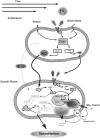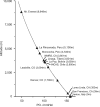Antenatal hypoxia and pulmonary vascular function and remodeling
- PMID: 24063380
- PMCID: PMC4527655
- DOI: 10.2174/1570161111311050006
Antenatal hypoxia and pulmonary vascular function and remodeling
Abstract
This review provides evidence that antenatal hypoxia, which represents a significant and worldwide problem, causes prenatal programming of the lung. A general overview of lung development is provided along with some background regarding transcriptional and signaling systems of the lung. The review illustrates that antenatal hypoxic stress can induce a continuum of responses depending on the species examined. Fetuses and newborns of certain species and specific human populations are well acclimated to antenatal hypoxia. However, antenatal hypoxia causes pulmonary vascular disease in fetuses and newborns of most mammalian species and humans. Disease can range from mild pulmonary hypertension, to severe vascular remodeling and dangerous elevations in pressure. The timing, length, and magnitude of the intrauterine hypoxic stress are important to disease development, however there is also a genetic-environmental relationship that is not yet completely understood. Determining the origins of pulmonary vascular remodeling and pulmonary hypertension and their associated effects is a challenging task, but is necessary in order to develop targeted therapies for pulmonary hypertension in the newborn due to antenatal hypoxia that can both treat the symptoms and curtail or reverse disease progression.
Figures







Similar articles
-
Lung EC-SOD overexpression attenuates hypoxic induction of Egr-1 and chronic hypoxic pulmonary vascular remodeling.Am J Physiol Lung Cell Mol Physiol. 2008 Sep;295(3):L422-30. doi: 10.1152/ajplung.90293.2008. Epub 2008 Jul 3. Am J Physiol Lung Cell Mol Physiol. 2008. PMID: 18599502 Free PMC article.
-
TBC3711, an ET(A) receptor antagonist, reduces neonatal hypoxia-induced pulmonary hypertension in piglets.Pediatr Res. 2001 Sep;50(3):374-83. doi: 10.1203/00006450-200109000-00013. Pediatr Res. 2001. PMID: 11518825
-
Improved pulmonary vascular reactivity and decreased hypertrophic remodeling during nonhypercapnic acidosis in experimental pulmonary hypertension.Am J Physiol Lung Cell Mol Physiol. 2012 May 1;302(9):L875-90. doi: 10.1152/ajplung.00293.2011. Epub 2012 Jan 27. Am J Physiol Lung Cell Mol Physiol. 2012. PMID: 22287610 Free PMC article.
-
Hypoxic pulmonary vasoconstriction: role of ion channels.J Appl Physiol (1985). 2005 Jan;98(1):415-20. doi: 10.1152/japplphysiol.00732.2004. J Appl Physiol (1985). 2005. PMID: 15591311 Review.
-
Hypoxia-induced pulmonary vascular remodeling: cellular and molecular mechanisms.Circ Res. 2006 Sep 29;99(7):675-91. doi: 10.1161/01.RES.0000243584.45145.3f. Circ Res. 2006. PMID: 17008597 Review.
Cited by
-
Long-Term High-Altitude Hypoxia and Alpha Adrenoceptor-Dependent Pulmonary Arterial Contractions in Fetal and Adult Sheep.Front Physiol. 2019 Aug 28;10:1032. doi: 10.3389/fphys.2019.01032. eCollection 2019. Front Physiol. 2019. PMID: 31555139 Free PMC article.
-
Gestational long-term hypoxia induces metabolomic reprogramming and phenotypic transformations in fetal sheep pulmonary arteries.Am J Physiol Lung Cell Mol Physiol. 2021 May 1;320(5):L770-L784. doi: 10.1152/ajplung.00469.2020. Epub 2021 Feb 24. Am J Physiol Lung Cell Mol Physiol. 2021. PMID: 33624555 Free PMC article.
-
High mobility group box 1 protein (HMGB1) as biomarker in hypoxia-induced persistent pulmonary hypertension of the newborn: a clinical and in vivo pilot study.Int J Med Sci. 2019 Aug 6;16(8):1123-1131. doi: 10.7150/ijms.34344. eCollection 2019. Int J Med Sci. 2019. PMID: 31523175 Free PMC article.
-
Biomechanical characterization of the passive response of the thoracic aorta in chronic hypoxic newborn lambs using an evolutionary strategy.Sci Rep. 2021 Jul 6;11(1):13875. doi: 10.1038/s41598-021-93267-9. Sci Rep. 2021. PMID: 34230509 Free PMC article.
-
Inherited risk plus prenatal insult caused malignant dysfunction in mesenteric arteries in adolescent SHR offspring.PLoS One. 2019 Apr 24;14(4):e0215994. doi: 10.1371/journal.pone.0215994. eCollection 2019. PLoS One. 2019. PMID: 31017969 Free PMC article.
References
-
- Martin JA, Hamilton BE, Sutton PD, Ventura SJ, Mathews TJ, Osterman MJ. Births: final data for 2008. Natl Vital Stat Rep. 2010;59(1):1, 3–71. - PubMed
-
- Walsh-Sukys MC, Tyson JE, Wright LL, et al. Persistent pulmonary hypertension of the newborn in the era before nitric oxide: practice variation and outcomes. Pediatrics. 2000;105(1 Pt 1):14–20. - PubMed
-
- Niermeyer S, Andrade Mollinedo P, Huicho L. Child health and living at high altitude. Arch Dis Child. 2009;94(10):806–11. - PubMed
-
- Greaves L. Sifting the evidence: Gender and tobacco control. World Health Organization. 2007:1–40.
Publication types
MeSH terms
Grants and funding
LinkOut - more resources
Full Text Sources
Other Literature Sources
Medical

